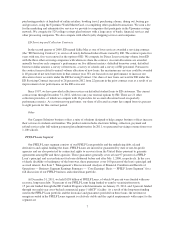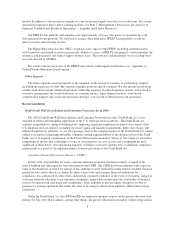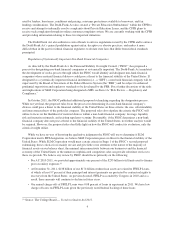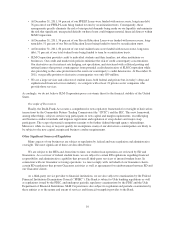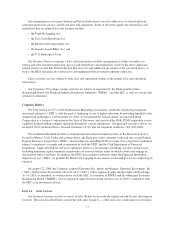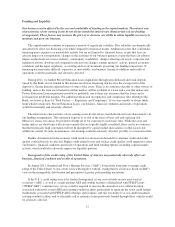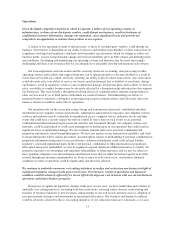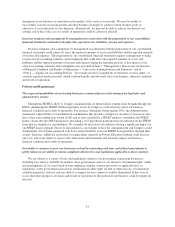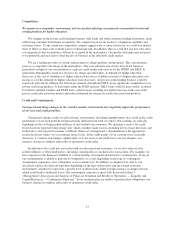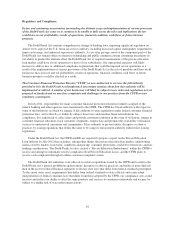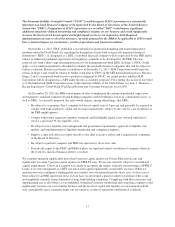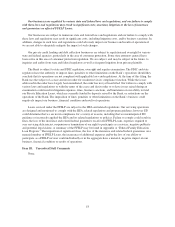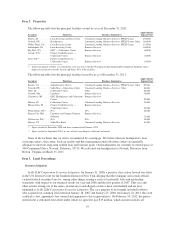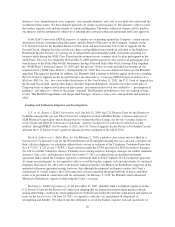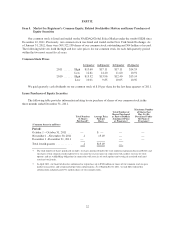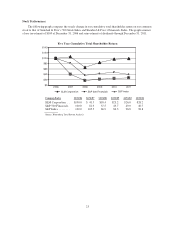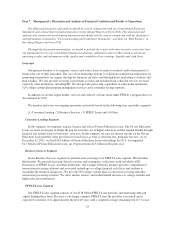Sallie Mae 2011 Annual Report Download - page 19
Download and view the complete annual report
Please find page 19 of the 2011 Sallie Mae annual report below. You can navigate through the pages in the report by either clicking on the pages listed below, or by using the keyword search tool below to find specific information within the annual report.The Financial Stability Oversight Council (“FSOC”) could designate SLM Corporation as a systemically
important non-bank financial company to be supervised by the Board of Governors of the Federal Reserve
System (the “FRB”). Designation of SLM Corporation as a so-called “SIFI” would impose significant
additional statutorily–defined monitoring and compliance regimes on our business and could significantly
increase the levels of risk-based capital and highly liquid assets we are required to hold. Required
implementation of some or all of the measures currently proposed by the FRB to be applicable to SIFIs would
have a material impact on our business, results of operations and financial condition.
On October 11, 2011, FSOC published a second notice of proposed rulemaking and related interpretive
guidance under the Dodd-Frank Act regarding the designation of non-bank systemically important financial
institutions (“SIFIs”). If designated as a SIFI, a non-bank financial company will be supervised by the FRB and be
subject to enhanced prudential supervision and regulatory standards to be developed by the FRB. The new
proposal sets forth a three-stage determination process for designating non-bank SIFIs. In Stage 1, FSOC would
apply a set of uniform quantitative thresholds to identify the non-bank financial companies that will be subject to
further evaluation. Based on its financial condition as of December 31, 2011, SLM Corporation would meet the
criteria in Stage 1 and would be subject to further evaluation by FSOC in the SIFI determination process. Because
Stages 2 and 3 as proposed would involve qualitative judgment by FSOC, we cannot predict whether SLM
Corporation will be designated as a SIFI under the rule as currently proposed. For a further discussion of our belief
as to the limited risk SLM Corporation poses to the financial stability of the United States, see Item 1 “Business—
Recent Legislation—Dodd-Frank Wall Street Reform and Consumer Protection Act of 2010.”
On December 20, 2011 the FRB issued proposed rules to implement the enhanced prudential supervisory
and regulatory standards required of bank holding companies with $50 billion or more in consolidated assets, as
well as SIFIs. As currently proposed, the rules would require, among other things, that SIFIs:
• Be subject to a minimum Tier 1 common risk-based capital ratio of 5 percent and generally be required to
comply with bank regulatory capital and leverage requirements, subject to any case-by-case exceptions as
the FRB might approve;
• Comply with formal regulatory liquidity standards and hold highly liquid assets on hand sufficient to
survive a projected 30-day liquidity crisis;
• Be subject to new liquidity risk management and governance requirements, approval of liquidity risk
models, and implementation of liquidity monitoring and compliance regimes;
• Employ a chief risk officer to report directly to the chief executive officer and a required risk committee
of the Board of Directors;
• Be subject to periodic company and FRB-run supervisory stress tests; and
• Periodically report to the FDIC and FRB on plans for rapid and orderly resolution of company affairs in
the event of a material financial distress or failure.
We currently maintain significantly more than 5 percent capital against our Private Education Loans and
significantly less than 5 percent capital against our FFELP Loans. We are not currently subject to consolidated
capital requirements. Unless an exception were made to recognize the unique, federally insured nature of FFELP
Loans, if we were designated as a SIFI, our risk-based capital requirements would likely increase. While we
maintain our own contingency funding plans and conduct our own internal periodic stress tests, we have never
been subject to an FRB supervised stress test nor have we developed a plan for orderly resolution of the scope
and magnitude currently being demanded of large bank holding companies. Complying with these measures and
implementing any or all of these as yet undefined, formalized statutory monitoring and compliance regimes could
significantly increase our cost of doing business and the levels of capital and liquidity we are required to hold
and, consequently, have a material impact on our business, results of operations and financial condition.
17


